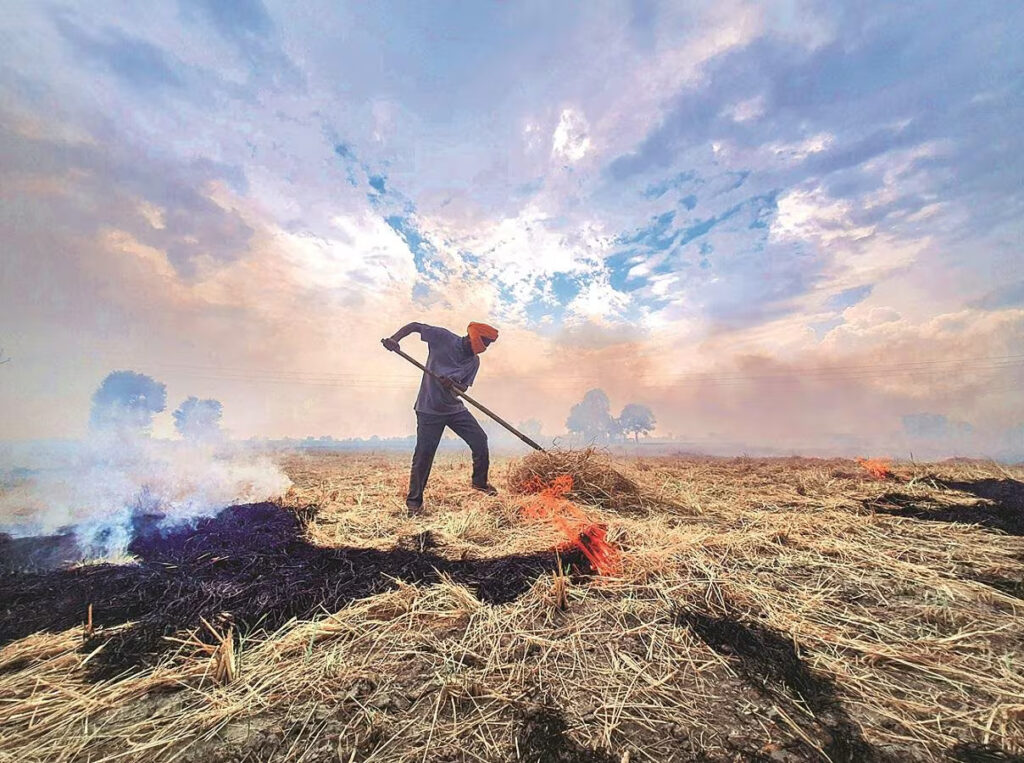Durgesh Jha

Conventional policy approaches are ineffective in tackling stubble-burning! A mix of regulations, bans, technology, and information often overlooks human behaviour, the problem’s core. Every winter, North Indian states are shrouded in smog, revealing a disconnect in our present strategies. We need to move beyond targeting structural or systemic factors in isolation and focus on the decision-maker to develop more effective policy interventions.
For the policy narrative around stubble burning to change, two facets of the issue must inform policy-making.
The first is the agricultural and economic constraints underlying stubble-burning as a practice. The agricultural cycle of rice-wheat cropping in Punjab and Haryana usually leaves farmers with just 15-20 days to clear their fields and prepare for rabi (winter) crop sowing. Delayed rice planting, mandated by regulations for groundwater conservation like the Punjab Preservation of Subsoil Water Act and the Haryana Preservation of Subsoil Water Act of 2009, further pushes rice harvest and wheat planting into a shorter time frame. While efficient for grain collection, combine harvesters leave behind 4-5 tons of rice straw per acre of land, which, unlike wheat straw, has limited commercial utility.
Therefore, for the average farmer, particularly small farmers, stubble burning is the most rational short-term decision, costing virtually nothing and clearing the fields within hours. Policy design must acknowledge the economics of stubble management, temporal limitations and agricultural constraints as realities instead of simply condemning them.
The second aspect of the problem is how most existing policies frame the problem, virtually ignoring the behavioural decision-making context of farmers. This is also reflective of a larger problem: a wide gap between policy design and on-ground implementation. While technically sound, policies often fail to account for practical constraints, treating stubble-burning in isolation rather than as part of the agricultural ecosystem.
Current policy approaches to stubble burning fall into 3 broad categories: fines, technological subsidies and awareness campaigns.
The punitive approach suffers from both implementation challenges and ineffectiveness. Despite NGT directives, enforcement is weak – only 11% of the penalties imposed in 2024 were recovered, revealing both capacity and behavioural limitations. Most farmers rationally expect a low chance of detection and punishment. Enforcement also requires significant administrative resources to monitor thousands of distributed fire events across vast rural landscapes. Behavioural research has shown positive incentives to be more effective at changing behaviour, especially when enforcement capacity is limited. Fines and penalties, a seemingly rational policy intervention, therefore often fail to produce expected outcomes.
Under the Central Sector Scheme on Promotion of Agricultural Mechanisation, considerable funds have been allocated to subsidise equipment like Happy Seeders. Subsidies are relatively more effective, but the transformative impact depends on the acceptance and integration of the subsidised technology. Often, a status quo bias leads to the continuation of traditional practices unless newer approaches have demonstrable advantages, leading to limited uptake. Risk aversion also makes farmers undervalue future benefits (environmental quality, soil health) compared to immediate costs (time, money, effort). Burning has immediate, tangible cost savings, while benefits from alternatives accrue over time.
Information campaigns, while necessary, have limited success in isolation. These tend to fail when they ignore social proof and practical economic realities. Many awareness initiatives treat farmers as perfectly rational individuals who will change their behaviour once educated and made aware.
To explore possible solutions, one must re-frame the problem and approach it from innovative vantage points.
The most cost-effective and foundational policy interventions include targeted behavioural nudges that work with, not against, established decision patterns. Tackling status quo bias and risk aversion requires social incentives for collective change. Community certifications publicly recognise villages performing well at sustainable stubble management, and combined with tangible benefits, tap into social motivations and community pride. Default-option modification entails strategically adjusting pre-selected choices, which are accepted unless actively changed, to influence behaviour. For instance, machinery rental services could automatically include stubble incorporation equipment with combine harvester rental unless farmers specifically opt out.
Even awareness campaigns are successful only when they work in combination, not isolation, with other initiatives, and provide localised, actionable information rather than general education. Newer mediums are needed because farmers need clear, practical evidence – not abstract, jargon-filled messages. Demonstration plots in a cluster of villages showing side-by-side yield comparisons between conventional and alternative methods can do this, countering misconceptions about yield impacts. One precedent is the Ministry of Agriculture and Farmers Welfare’s nationwide Cluster Frontline Demonstration (CFLD) programme under the National Food Security Mission-Pulses. Combined with yield guarantee programs that compensate productivity losses in the first year of adoption, these demonstrations directly tackle risk aversion.
Establishing carbon markets to create direct economic incentives for sustainable stubble management is promising. Examples include California’s rice cultivation protocol (under the state’s cap-and-trade program) and Australia’s Carbon Farming Initiative, which allow farmers to trade carbon credits for practices that reduce methane emissions and sequester carbon. India’s institutions presently remain underprepared to scale such solutions, despite their benefits. Implementation is complex, requiring the development of standardised measurement protocols for carbon sequestration from stubble, the establishment of verification mechanisms, and connecting farmers to carbon markets.
Developing market linkages that transform stubble from waste into valuable raw material allows circular economy practices to be adopted more widely. The bio-CNG plant set-up in Sangrur, Punjab, purchases rice straw from farmers at ₹1,500-2,000 per ton, converting it into compressed biogas for use as vehicle fuel. This creates a direct economic incentive for stubble collection, while also increasing renewable energy production. For scaling circular economy practices, decentralised processing capacity is equally important. In Haryana, FPOs have composting units that convert stubble into valuable organic fertiliser, which is then sold to member farmers or organic produce markets. Usage of rice straw by the paper and packaging industries demonstrates the importance of establishing collection networks to simplify logistics and ease farmer participation. Scaling these and other circular-economy solutions necessitates coordinated public-private partnerships.
The way forward requires three interconnected shifts in the policy narrative, based on a holistic rethinking of the problem. The first shift is from punitive measures and negative incentives to a preventive approach that focuses on making sustainable practices more accessible, affordable, and advantageous through positive incentives. The second shift is from isolated to integrated policy frameworks that align procurement timelines, cropping recommendations, subsidy structures, and environmental regulations toward consistent objectives to solve the problem at a deeper level by addressing agricultural and economic constraints. This means rethinking and contextualising stubble management as a component of agricultural systems design, and not an isolated environmental compliance issue. The third, and arguably the most important, shift is from technology-first thinking to behaviour-centred design. Instead of developing purely technical solutions, based on the assumption or expectation of adoption, policies must account for and reflect existing behavioural patterns.
Durgesh Jha is an intern at PANJ Foundation.
